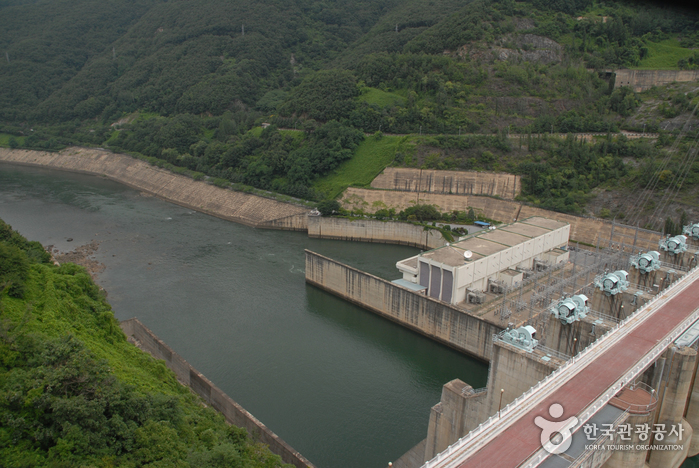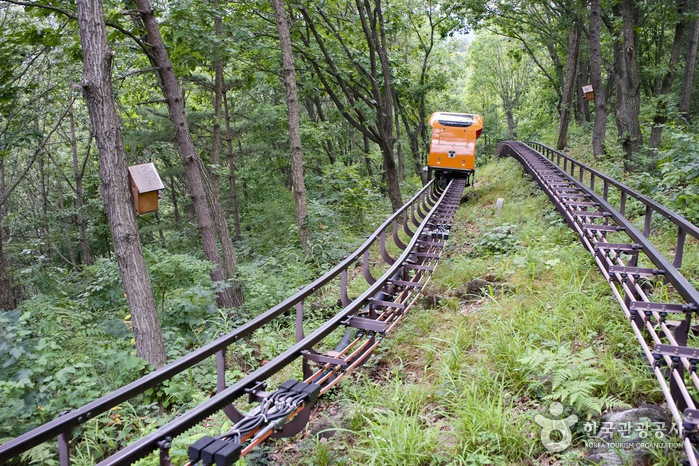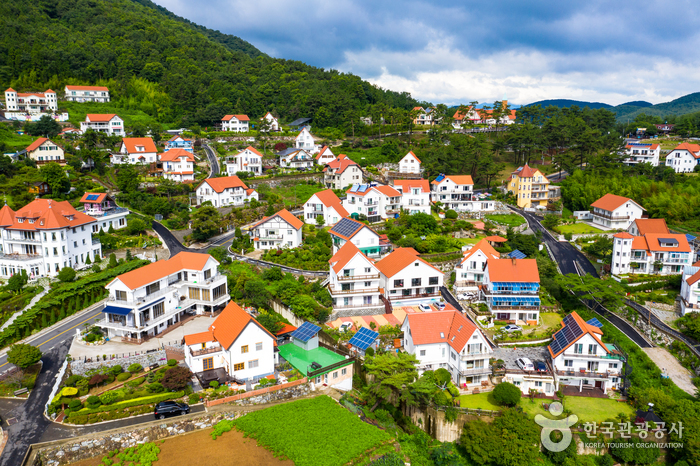Chungju Dam (충주댐)
2021-04-29
737, Chungjuhosu-ro, Chungju-si, Chungcheongbuk-do
+82-43-840-1207
Chungju Dam is the nation’s largest multipurpose concrete dam and plays a role in water resources planning and management, prevention of flood damage, and electric power production. The dam area features various facilities like the Water Exhibition Hall, Memorial Tower, a resting area, and a tour boat dock. As for the structure, the dam is 97.5 meters high and 447 meters long. Beneath the main dam, there is a balancing reservoir dam which is 21 meters high and 480.7 meters long.
Cheongpungho Scenic Monorail (청풍호 관광모노레일)
2024-03-13
879-17 Cheongpungmyeongwol-ro, Cheongpung-myeon, Jecheon-si, Chungcheongbuk-do
+82-43-653-5120
The Cheongpungho Scenic Monorail offers a unique journey along a three-kilometer track from Dogok-ri in Cheongpung-myeon, Jecheon, to Bibongsan Mountain, situated at 531 meters above sea level. Typically, reaching the summit of Bibongsan Mountain on foot from Dogok-ri takes about an hour. However, the monorail service significantly reduces this time by half. Additionally, passengers can enjoy panoramic views of Cheongpungho Lake from various perspectives during their ride.
Deoksugung Palace's Daehanmun Gate (덕수궁 대한문)
2025-01-13
99 Sejong-daero, Jung-gu, Seoul
+82-2-771-9951
Located near City Hall station, Daehanmun Gate is the main gate of Deoksugung Palace, one of the princiapl five palaces of Joseon dynasty. The name "Daehan" means wish for eternal prosperity of the Korean Empire. In front of the gate, the Palace Royal Guard Changing Ceremony is held twice daily, along with the reproduction of costumes and style throughout the year.
Seondol Cliff [National Geopark] (선돌 (강원고생대 국가지질공원))
2022-12-28
373-1, Bangjeol-ri, Yeongwol-gun, Gangwon-do
+82-1577-0545
Seondol Cliff features a large split rock standing over the curving river below. The scene created by these two natural elements appears other-worldly. A rocky outcrop appears to have been cut away from the main cliff with a giant knife. Geologically, it was formed by corrosion of the limestone bedrock.
Busandaegyo Bridge (부산대교)
2025-10-23
41 Namhang-ro 9beon-gil, Yeongdo-gu, Busan
+82-51-600-4000
Built in 1980, Busandaegyo Bridge connects Yeongdo Island to the mainland. It serves as an industrial road that facilitates the transport of freight and cargo from Yeondong-gu District, the center of the shipbuilding industry and an emerging port.
Busandaegyo Bridge is 694 meters long and 20 meters wide, with 16 meters for cars and 2 meters of sidewalk on each side. Compared to other bridges built around the same time, Busandaegyo Bridge has a greater significance in the hearts of the citizens as it was built to commemorate the 100th anniversary of Busan Port and symbolizes the development of the city.
German Village (독일마을)
2022-12-26
89-7 , Dogil-ro, Namhae-gun, Gyeongsangnam-do
+82-55-867-8897
The German Village was built for Korean residents who returned from living in Germany. Many Koreans lived in Germany where they earned foreign currency during the modernization of Korea in the 1960s. The area is now a unique tourism spot related to German culture. In 2001, the areas of Mulgeon-ri, Samdong-myeon, Namhae-gun, where the Windbreak Forest (Natural Monument) is located, underwent a development worth 3 billion won ($2 million USD) implemented by Namhae-gun and eventually formed a village spanning over 99,174 ㎡.
Korean residents in Germany directly imported materials from Germany to build German-style houses. Some villagers who make frequent visits to Germany operate their vacant house as a tourist guesthouse. Attractions nearby are the Windbreak Forest and the Mulmi Coastal Road, one of the most beautiful coastal drives in Korea.
Chungjuho Lakeside Resort Cheongpungnaru (충주호관광선 청풍나루)
2020-03-24
54, Munhwajae-gil, Jecheon-si, Chungcheongbuk-do
+82-43-647-4566
Located in Chengpung-myeon, Jecheon-si, Chungcheongbuk-do, Cheongpungnaru is the starting and ending point for pleasure boat commuting on Cheongpungho Lake. The ferry offers great views of the lake and its surroundings. In particular, the most popular course is the route between Cheongpung and Janghoenaru including Oksunbong Peak, Gudambong Peak and Geumsusan Mountain. Boarding takes place in front of Cheongpung Cultural Heritage Complex.
Namhae Geumsan Boriam Hermitage (금산 보리암(남해))
2022-12-29
665, Boriam-ro, Namhae-gun, Gyeongsangnam-do
+82-55-860-5800
Boriam Hermitage sits atop Geumsan Mountain (alt. 704 m). The mountain was once called Bogwangsan Mountain as it was home to Bogwangsa Temple, founded by Monk Wonhyo. The name Geumsan was bestowed upon the mountain by King Taejo after he founded the Joseon dynasty. Along with Bomunsa Temple in Ganghwado Island and Hongnyeonam Hermitage in Naksansa Temple, Boriam Hermitage is known as one of the most prestigious prayer spots in Korea.
Peace Park (평화공원)
2021-09-17
10, Sinseon-ro 447beon-gil, Nam-gu, Busan
+82-51-607-4541
Peace Park is the representative citizen's rest area in Busan, filled with over 30,000 camellia and pine trees. A fountain in the middle of the park provides a fun water playground for children, and a popular date spot with beautiful lights at night.
House N Garden (원예예술촌)
2020-06-01
39, Yesul-gil, Namhae-gun, Gyeongsangnam-do
+82-55-867-4702
House N Garden was created by people who love gardens including Park Won-suk, the TV actress. The garden is comprised of themed private gardens such as the perfume, palm tree, topiary, vegetable, windmill, spa, flower roof gardens and other facilities including a path, a pond, observation deck, a pavilion, a fountain, flower road, flower fences, and a green house. In addition, the garden offers the facilities like a cutting-edge video room, performance room, exhibition room, a café, and a guest house for visitors.


![Seondol Cliff [National Geopark] (선돌 (강원고생대 국가지질공원))](http://tong.visitkorea.or.kr/cms/resource/00/2026100_image2_1.jpg)


 English
English
 한국어
한국어 日本語
日本語 中文(简体)
中文(简体) Deutsch
Deutsch Français
Français Español
Español Русский
Русский